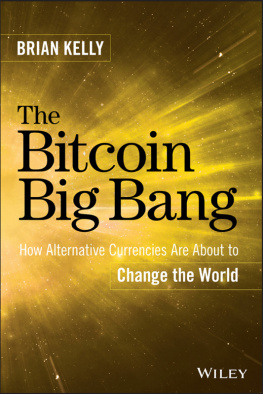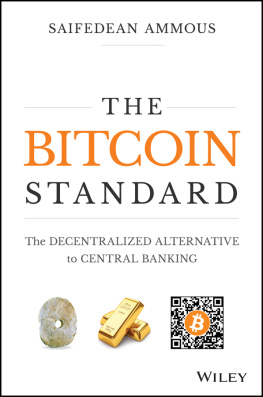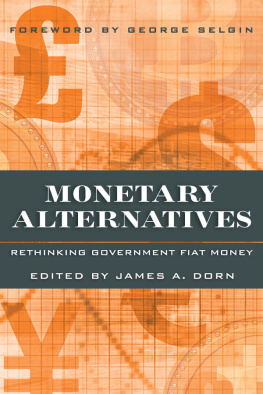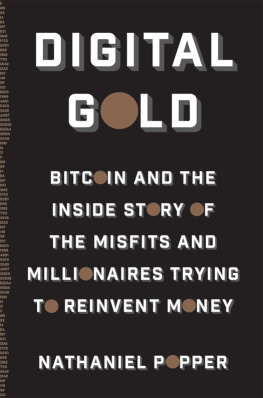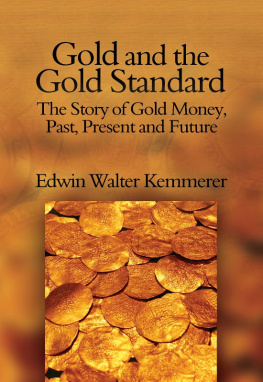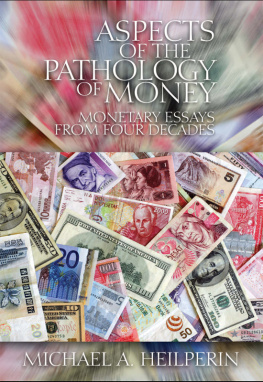Szabo
Bundesbank
Goldthwaite
Goldthwaite
Gleeson-White
The terms hierarchy of money, hierarchy of balance sheets, and disciplinary constraint come from Perry Mehrlings 2012 paper The Inherent Hierarchy of Money in which he outlines this naturally occurring hierarchy in monetary systems. His paper is foundational to the framework of this book.
McCusker
Padgett
To this day, sterling silver refers to silver of 92.5% purity.
A troy ounce is about 10% heavier than a regular ounce. It has been used to measure the weight of precious metals since at least the sixteenth century. Mentions of precious metal weights in this book are made in troy ounces.
Executive Order 6102 was repealed in 1974 when ownership of gold was again legalized.
The Fed creates reserves by purchasing U.S. Treasuries from dealer banks called Primary Dealers. Primary Dealers are an extension of the Federal Reserves monetary policy because they are the sole recipients of second-layer money in the Feds reserve creation process.
T-Bills have maturities of 364 days or less, while longer-term Treasury bonds have maturities up to 30 years.
The offshore dollar system includes all banks outside of the United States and outside the jurisdiction of the Federal Reserve system, not just ones in Europe.
In Figure 13, wholesale Eurodollars include cash-instruments issued in the offshore dollar system such as Eurodollars, Certificates of Deposit, and Commercial Paper.
BIS data
An arbitrage trade by large hedge funds between Treasury bonds and Treasury futures derivatives contracts has received blame for causing enormous disruptions in the Treasury market in March 2020, however the debate continues.
A University of Cambridge study estimated there are 101 million unique Total Cryptoasset Users across 191 million accounts globally in September 2020.
The BTC/USD price and total market value used throughout this book were $34,000 and $630 billion, respectively, a snapshot taken on Bitcoins twelfth birthday, January 3, 2021. Data: Coin Metrics.
This book will use he/his to refer to Satoshi Nakamoto for simplicity while acknowledging that Satoshis identity remains unknown.
Bitcoin uses a specific type of SHA2 called SHA-256
There are 100,000,000 sats, named after Satoshi, in 1 BTC. Sats are BTCs sub-unit (think of dollars and cents). 21,000,000 BTC = 2,100,000,000,000,000 sats.
http://p2pfoundation.ning.com/forum/topics/bitcoin-open-source
https://bitcointalk.org/index.php?topic=2500.70;wap2
Total market value of BTC = BTC/USD price current BTC supply
Assuming a $10 trillion total market value for gold and approximately 20 million BTC (estimated supply in 2025)
Check Lock Time Verify (BIP 65), CheckSequenceVerify (BIP 68, 112, 113), and Segregated Witness (BIP 141, 143, 147)
OCC, Interpretive Letter 1174.
About the Author
Nik Bhatia is a financial researcher, CFA charterholder, and Adjunct Professor of Finance and Business Economics at the University of Southern California Marshall School of Business where he teaches Applied Finance in Fixed Income Securities. Previously, Nik worked the US Treasuries trading desk for a large institutional asset manager and has extensive trading experience in money markets and interest rate futures. After starting his teaching career, Nik felt the urge to bring his research on both the international monetary system and Bitcoin together as one to write Layered Money: From Gold and Dollars to Bitcoin and Central Bank Digital Currencies. He has a BA in Social Sciences from University of Southern California and a Master in Finance from IE Business School in Madrid, Spain. Nik lives in Los Angeles, CA with his wife and young daughter.
LayeredMoney.com
Layered Money
Copyright 2021 by Nik Bhatia
All rights reserved. No part of this publication may be reproduced, distributed, or transmitted in any form or by any means, including photocopying, recording, or other electronic or mechanical methods, without the prior written permission of the publisher, except in the case of brief quotations embodied in critical reviews and certain other noncommercial uses permitted by copyright law.
ISBN 978-1-7361105-0-8
Cover and ebook conversion by Anton Khodakovsky
This book is dedicated to my wife
and life partner Chandni and our sweetheart daughter Ria Tara
Preface
We stand today facing an international monetary system on the precipice of overhaul, something that rarely occurs. This book was written to provide a topography of money at these uncertain crossroads. Maps help us navigate geographies and terrains, but until now they have never been associated with money. This book provides a map of our financial system throughout time, and a preview of what the map of digital money will look like in the future. It endows the reader with a new framework called layered money to describe our evolving monetary system, help us navigate the geomorphology of money, and explain how different forms of money relate to each other.
By tracing the evolution of layered money, we gain a fascinating perspective on how and why humans interact with their chosen currencies. Along with dissecting the progression of currency, this book tackles a key question: what does the future of money entail? Many will say its digital, but to most of us, money already seems digital. We use smartphone applications to manage checking accounts and make contactless payments and are increasingly surrendering to a cashless existence. But now that Bitcoin has captivated the worlds monetary imagination, digital money has taken on a whole new meaning.
Part of the reason for this ambiguity is that monetary science, or the study of money, lacks the proper vernacular and theoretical framework to incorporate Bitcoin; it desperately needs a fresh update to include this novel form of money. Updates to monetary science are extremely rare, and in order to explain the enormous one about to occur, we have to look at its past to properly contextualize Bitcoins impact on the future of money. And the update is well worth it; Bitcoin and its many iterations provide the fresh start in transparency and choice the world needs as we face the next iteration of money.
This book is an attempt to understand and explain how this integration of Bitcoin will occur, and how it will change the fate of our monetary system. In order to do that, we need a more accessible way to understand monetary science itself, which historically has been shrouded in doctorate level economic theoryvery few truly understand where money comes from, or what a monetary system even is. The goal of this book is to reframe our monetary system for the uninitiated and explain it from the beginning.
Most importantly, readers will come away with an understanding that money is a layered system. Using original layered terminology, this book will explain why human beings began using monetary systems instead of coins, how these systems evolved, and how complicated and multilayered they have become today. Readers should be able to use this book to understand on which layer of money their assets are located and navigate between the layers of money. In a future world of currency choice, being able to navigate the monetary map will be empowering.
Next page

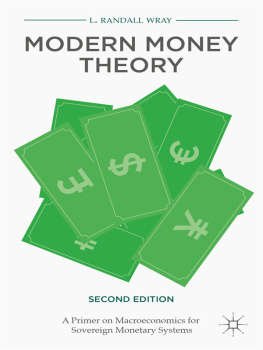

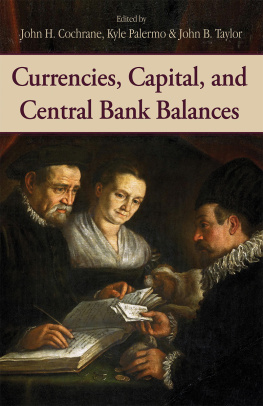
![Brian Kelly [Brian Kelly] - The Bitcoin Big Bang: How Alternative Currencies Are About to Change the World](/uploads/posts/book/119681/thumbs/brian-kelly-brian-kelly-the-bitcoin-big-bang.jpg)
